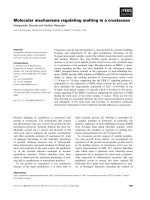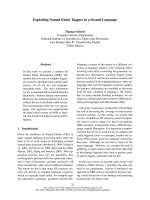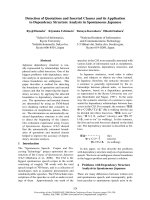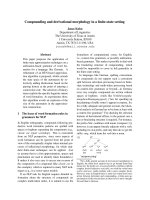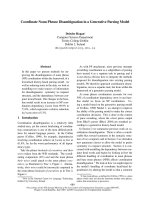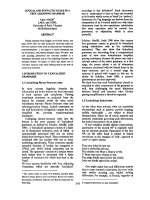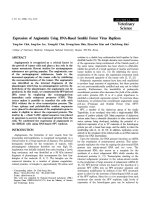Báo cáo khoa học: " Estimation of Paratuberculosis Prevalence in Dairy Cattle in a Province of Korea using an Enzyme-linked Immunosorbent Assay: Application of Bayesian Approach" ppt
Bạn đang xem bản rút gọn của tài liệu. Xem và tải ngay bản đầy đủ của tài liệu tại đây (77.54 KB, 6 trang )
J O U R N A L O F
Veterinary
Science
J. Vet. Sci. (2003), 4(1), 51-56
Abstract
8)
To draw inferences about the sensitivity and
specificity of the new ly developed ELISA test for
bovine paratuberculosis (PTB) diagnosis and posterior
distribution on the prevalence of PTB in a province
of Korea, w e applied Bayesian approach w ith Gibbs
sampler to the data extracted from the prevalence
study in 1999. The data w ere from a single test results
w ithout a designated gold test.
The prevalence estimates for PTB in study po-
pulation ranged 3.2
~
5.3% for conservative and 6.7
~
7.1% for liberal, depending on the priors used. The
simulated specificities of the ELISA close to one
another, ranging 84.7
~
90.6%, whereas the sensitivity
w as somewhat spread out depending largely on the
priors with a range of 46.4
~
88.2%. Our findings indicate
that the ELISA method appeared useful as a screening
tool at a minimum le vel in comparison to other
diagnostic tests available for this dise ase in term s of
sensitivity. However, this advantage comes at a cost
of having low specificity of the test.
Key words
: Mycobacterium paratuberculosis, ELISA, Bayesian,
Gibbs sampling
Introduction
Paratuberculosis (PTB) caused by Mycobacterium avium
subsp. paratuberculosis has been reported in Korea for
several decades and affects a large proportion of dairy cattle
throughout the country. Few studies so far have been
reported on the prevalence at individual animal and at herd
level in Korea, although PTB had been designated as a
notifiable disease since 1961. Based on the reports from
*
Corresponding author: Son-il Pak
Department of Veterinary Medicine, Kangwon National University,
Chuncheon, Kangwon-do 200-701, Korea
Tel: +82-33-250-8672; Fax: +82-33-244-2367
E-mail:
other studies [20, 21] the prevalence ranged 1.7-13.4%, but
remains largely unknown.
For PTB diagnosis, bacterial identification in bovine feces
has been considered the gold standard [29]. This method,
however, is of limited use [6, 27, 32]. The enzyme-linked
immunosorbent assay (ELISA) is the most commonly used
serologic test because of its superior sensitivity relative to
other serologic testing methods. The sensitivity of the
commercially available kits has been reported to range from
15 to 87% depending on clinical stage of disease [8] and
specificity was reported ranging from 99 to 99.7% [7].
Estimating the accuracy of a diagnostic test is straight-
forward in situations when gold standard methods with no
errors are available. In many clinical settings, however,
there is no gold standard to determine dichotomously an
animal has the disease under study. When an imperfect test
with less than 100% of sensitivity and specificity is used to
determine disease status, biases are introduced into both
measurements of test performance, and led to over-or
under-estimates of a tests true capabilities [24, 31]. This
makes it impossible to determine the sensitivity and
specificity of a single diagnostic test with a traditional
approach. The use of an alternative approach, therefore, has
been proposed to deal with the situation when gold standard
does not exist [9, 10, 18]. Approaches to assess diagnostic
accuracy of a test in the absence of a gold standard have
been reviewed in both human and veterinary medicine [1, 2,
3, 11, 12, 14, 15, 17, 24].
One of co-authors (DK) of the present paper developed a
new ELISA method using the recombinant 34kDa protein,
which is species-specific epitope of M. paratuberculosis [22].
This test is designed as a screening tool to detect antibodies
to native protein in sera from PTB infected cattle and was
applied to field samples as a single test to estimate the
prevalence of PTB in study population. We applied Bayesian
approach to the results of their study to draw inferences
about the prevalence of the PTB in the target population
along with the posterior distribution on the performance of
the test.
Estimation of Paratuberculosis Prevalence in Dairy Cattle in a Province of Korea using
an Enzyme-linked Immunosorbent Assay: Application of Bayesian Approach
Son-il Pak*, Doo Kim and Mo Salman1
Department of Veterinary Medicine, Kangwon National University, Chuncheon 200-701, Korea
1Animal Population Health Institute, College of Veterinary Medicine and Biomedical Sciences,
Colorado State University, Fort Collins, CO 80523-1676, USA
Received November 23, 2002 / Accepted February 26, 2003
52 Son-il Pak, Doo Kim and Mo Salman
Materials and Methods
Study population and sampling scheme
In 1999, a total of 305,513 dairy cattle of at least 2 years
of age or more were recorded in the Korean nationwide
government statistics (Ministry of Agriculture and Fishe-
ries, Korea, 1999). Kangwon province, the study area
consisted of 25,532 or 8.4% of the total cattle population.
Based on an estimated PTB prevalence of 10-15%, herds
ranging 138-196 are needed to obtain 5% desired accuracy
with 95% confidence [5]. Due to financial restriction and
incompliance of the farm owners for participation 162 herds
with 2,261 cattle (8.9% of total population in study area)
were finally selected. Blood samples were collected from
cattle that were greater than 2 years old during the period
March through April 1999. Veterinary officials of the local
laboratories in the province collected all samples. The detail
procedures on the preparation of antigen for ELISA are
described previously [22].
Assumptions for the parameters
Within Bayesian inference framework, some of the
unknown parameters typically required to be assumed
known in order to draw meaningful posterior distributions
about the remaining parameters of interest [18]. To put this
perspective to work in our current analysis, we used both
informative and non-informative approaches to define prior
distribution of the parameters. Prior information was
basically assumed in the form of a beta density, B(
α
,
β
), as
suggested by many authors [12, 15, 17, 23]. The prior
density for each test parameter was selected with the mean
of the beta distribution given by
α
/
α
+
β
, and the standard
deviation, [
αβ
/ (
α
+
β
)2(
α
+
β
+1)]0.5, and was formed cove-
ring 4 standard deviation (SD) of probable range.
Modeling scenario in Bayesian analysis and
assumptions for the priors
Since the present ELISA is newly developed and
employed once without gold standard the prior information
on the sensitivity and specificity, denoted by
η
and
θ
,
respectively, was primarily formed using the information
obtained from the results against standard sera.
For prevalence (
π
), we considered several sets of beta
priors from the previously reported studies [20, 21]. A
summary of the estimates of prevalence and the corres-
ponding beta priors using these rates were summarized in
Table 1. The SD was not reported in the original papers so
that we assumed them 0.01 for each study. This value was
formed to cover 4 SD of most likely range of prevalence,
6-10%. As an alternative way of increasing the precision of
the estimate we combined all these results (932 positive out
of 10,289 samples), yielding a prior of B(74.5,748.2). By
using the ELISA, of 2,261 serum samples screened 372 were
positive, of which 75 samples were confirmed by the
Western Blot test. This result was considered as the
likelihood ratio in the calculation of the posterior using the
formula: Posterior
∝
Prior x Likelihood. We therefore com-
bined the observed data with the priors so that six
posteriors were constructed for
π
~ B(127.0,2826.8),
B(156.6,2963.2), B (230.4,3190.1), B(116.8,2768.3),
B(77.8,2349.3), and B(149.5,2934.2). Of these priors we
presented results from three priors because of similar
outputs between them.
When using the standard positive and negative sera the
ELISA showed 96.7% (29 of 30) of
θ
and 83.3% (25 of 30)
of
η
. Thus, the prior for specificity was considered as a
θ
~B(30,2) assuming a uniform prior, which was intended to
avoid minimize the effect of priors on posteriors. As an
alternative we assumed the specificity of the test as at least
95% and less than 99%. Based on this assumption we con-
structed parameters of 281.3 and 8.7 for beta distribution,
and these values were updated using the observed data,
yielding a posterior of a
θ
~B(310.3,9.7).
For sensitivity, as a non-informative approach the pos-
terior distribution was considered as a B(26,6) based on the
result against standard sera. We also used information
derived from the literatures [8, 25, 30, 32], which was
intended to see the impact of priors for prevalence. These
priors are based on the assumption that the sensitivity of
the ELISA may similar at least to those of other commonly
used ELISA. We thus considered five priors of sensitivity:
η
~B(696.5,366.7), B (210.7.145.1), B(186.1,215.1),
B(49.0,29.1), and B(422.5,490.8) and combined the resulting
beta prior with the observed data to elicit posteriors. SD of
the sensitivity was calculated from the point estimates
described in each paper, using the normal approximation to
Table 1.
Prevalence estimates of PTB for various tests and beta priors
Estimates
Study (No. positives/No. tested) Beta priors Diagnostic test used
Kim et al. (1994)
Kim et al. (1997)
Total
205 / 2,719
245 / 2,641
363 / 2,719
109 / 1,633
10 / 577
932 / 10,289
B (52.0, 640.8)
B (81.6, 777.2)
B (155.4, 582.3)
B (41.8, 582.3)
B (2.8, 163.3)
B (74.5, 748.2)
Agar gel immunodiffusion
Complement fixation
ELISA
Intradermal skin test
Absorbed ELISA
-
Estimation of Paratuberculosis Prevalence in Dairy Cattle in a Province of Korea using an Enzyme-linked Immunosorbent Assay: Application of Bayesian Approach
53
the binomial distribution in terms of the sampling dis-
tribution [28]. The combined estimate of sensitivity has a
median of 54%, providing a posterior distribution of a
η
~B(70.5,43.7). In summary, we considered main scenario
as B(149.5,2934.2), B(310.3,9.7), and B(70.5,43.7) for ,
π
,
η
,
and
θ
, respectively. Other scenarios can be considered as
sensitivity analyses.
For parameter estimation S-plus (Mathsoft, Inc.)
programs for the Gibbs sampler [16, 23] were used. We run
for 20000 cycles, the first 1000 to assess convergence and
the remaining cycle for inference.
Results
The median and 95% credible interval of PTB prevalence
from the simulated values for sensitivity and specificity
were summarized in Table 2. Among the three priors
evaluated the prior,
π
~B(230.4,3190.1) yielded estimates
ranging from 6.7 to 7.1% in every combinations of sen-
sitivity and specificity. In contrast, the other two priors
showed similar results with no great difference in posteriors
between them.
Posterior medians and 95% credible intervals of the
sensitivity and specificity by three different priors of
prevalence (one for main prior and two for extreme prior)
were given in Table 3 and 4. Sensitivity ranged 46.4-88.2%,
with a great variation depending on the priors used:
46.4-47.7% for B(186.1,215.1), 62-65.9% for B(70.5,43.7) and
81.9-88.2% for B(26,6). For specificity two posteriors yielded
similar estimates in every combination of sensitivity and
prevalence, ranging 84.7-90.6%.
Discussion
Bayesian methods for estimating the prevalence have
been utilized by many researchers [13, 15, 16, 17, 18, 19,
Table 2.
Median (95% credible interval) of PTB prevalence (
π
) from the simulated values after burn-in phase using two
specificities (
θ
), B(30,2) and B(310.3,9.7), by various prior of sensitivity (
η
)
Prior of
π θ
Posterior distributions for
π
η
~B (26, 6)
η
~B (696.5, 366.7)
B (149.5,2934.2) B (30, 2) 0.049 (0.042 - 0.056) 0.048 (0.041 - 0.057)
B (310.3, 9.7) 0.052 (0.044 - 0.060) 0.051 (0.044 - 0.060)
B (230.4,3190.1) B (30, 2) 0.067 (0.060 - 0.077) 0.067 (0.059 - 0.078)
B (310.3, 9.7) 0.071 (0.060 - 0.081) 0.070 (0.061 - 0.080)
B (77.8,2349.3) B (30, 2) 0.032 (0.026 - 0.040) 0.032 (0.026 - 0.040)
B (310.3, 9.7) 0.035 (0.026 - 0.043) 0.034 (0.027 - 0.042)
η
~B (210.7, 145.1)
η
~B (186.1, 215.1)
B (149.5,2934.2) B (30, 2) 0.049 (0.041 - 0.057) 0.048 (0.041 - 0.056)
B (310.3, 9.7) 0.051 (0.044 - 0.060) 0.050 (0.042 - 0.058)
B (230.4,3190.1) B (30, 2) 0.068 (0.060 - 0.077) 0.067 (0.060 - 0.076)
B (310.3, 9.7) 0.070 (0.062 - 0.079) 0.069 (0.061 - 0.078)
B (77.8,2349.3) B (30, 2) 0.032 (0.025 - 0.040) 0.032 (0.025 - 0.039)
B (310.3, 9.7) 0.034 (0.027 - 0.042) 0.033 (0.027 - 0.041)
η
~B (49.0, 29.1)
η
~B (422.5, 490.8)
B (149.5,2934.2) B (30, 2) 0.048 (0.041 - 0.055) 0.049 (0.042 - 0.058)
B (310.3, 9.7) 0.051 (0.043 - 0.060) 0.050 (0.043 - 0.058)
B (230.4,3190.1) B (30, 2) 0.068 (0.060 - 0.077) 0.068 (0.060 - 0.076)
B (310.3, 9.7) 0.071 (0.062 - 0.080) 0.069 (0.062 - 0.079)
B (77.8,2349.3) B (30, 2) 0.032 (0.025 - 0.039) 0.032 (0.025 - 0.039)
B (310.3, 9.7) 0.034 (0.027 - 0.042) 0.033 (0.027 - 0.040)
η
~B (70.5, 43.7)
B (149.5,2934.2) B (30, 2) 0.048 (0.041 - 0.057)
B (310.3, 9.7) 0.050 (0.044 - 0.059)
B (230.4,3190.1) B (30, 2) 0.068 (0.060 - 0.076)
B (310.3, 9.7) 0.070 (0.062 - 0.079)
B (77.8,2349.3) B (30, 2) 0.032 (0.026 - 0.039)
B (310.3, 9.7) 0.034 (0.027 - 0.041)
54 Son-il Pak, Doo Kim and Mo Salman
24]. In the context of Bayesian analysis, in particular, for a
single diagnostic test with small sample size relative to the
number of parameters to be estimated, at least two of the
three parameters need to have good priors to obtain
reasonable posteriors. In other words, in cases where there
are relatively few data per parameter, drawing useful
inferences require substantive prior information. Among the
three priors tested for prevalence,
π
~B(230.4,3190.1) yield-
ed 6.7-7.1% and the others yielded estimates of 3.2-5.3% in
prevalence. We obtained information on prevalence from two
previous studies conducted at the regional level. These
results, however, have some limitations for its use in
producing priors for prevalence because the results showed
great variation depending on the diagnostic test employed,
the study population such as age of the tested animals,
different clinical stages of the tested animals, study region,
and the study design including sample size. In addition
these results are based only on the diagnostic test without
employing confirmatory test.
Without comprehensive information available for pre-
valence we could not certain which estimate is more
reasonable for the study population. However, we believe
that both are a bit underestimated values. The information
used for constructing priors in the current study was from
the results conducted in several other provinces with
different diagnostic tests, leading to different posteriors in
prevalence. Large proportion of animals with stage of
infection not detectable with ELISA may account for this.
Short period of sampling for 2 months may not provide the
real situation of population dynamics. Another possibility is
that survey sampling error such as bias attributed by
participation of farm owners with well-managed may be
responsible for low prevalence.
The specificities produced by two priors seemed to be
fairly stable with no great variations in posteriors, ranging
84.7-90.6%, which are a bit lower than previously reported
[8, 26]. This result may be related to the prior for
prevalence, in that expected specificity vary with disease
Table 3.
Posterior means and 95% credible intervals of the sensitivity (
η
) by three different priors of prevalence, one for
main prior and two for extreme priors, using two prior for specificity,
θ
~B(310.3,9.7) and
θ
~B(30,2)
Prior of
π
Posteriors of
η
for:
B (70.5, 43.7) B (186.1, 215.1) B (26, 6)
θ
~B (310.3, 9.7)
B (77.8, 2349.3) 0.639 (0.547 0.725) 0.469 (0.417 0.518) 0.861 (0.757 0.940)
B (149.5, 2934.2) 0.649 (0.559 0.729) 0.476 (0.427 0.520) 0.868 (0.743 0.946)
B (230.4, 3190.1) 0.659 (0.568 0.740) 0.477 (0.427 0.525) 0.882 (0.769 0.946)
θ
~B (30, 2)
B (77.8, 2349.3) 0.623 (0.535 0.715) 0.464 (0.419 0.512) 0.819 (0.664 0.926)
B (149.5, 2934.2) 0.623 (0.535 0.709) 0.464 (0.415 0.513) 0.833 (0.687 0.938)
B (230.4, 3190.1) 0.620 (0.522 0.704) 0.465 (0.417 0.513) 0.829 (0.669 0.927)
Table 4.
Posterior means and 95% credible intervals of the specificity (
θ
) by three different priors of prevalence (
π
), one
for main prior and two for extreme priors, using two prior for sensitivity (
η
), B(186.1,215.1) and B(70.5,43.7)
Prior of
π
Posteriors of
θ
for:
B (30, 2) B (310.3, 9.7
η
~B (186.1, 215.1)
B (77.8, 2349.3) 0.847 (0.830 0.862) 0.863 (0.849 0.877)
B (149.5, 2934.2) 0.852 (0.836 0.867) 0.869 (0.855 0.885)
B (230.4, 3190.1) 0.859 (0.841 0.876) 0.877 (0.861 0.892)
η
~B (70.5, 43.7)
B (77.8, 2349.3) 0.852 (0.835 0.868) 0.869 (0.854 0.885)
B (149.5, 2934.2) 0.860 (0.844 0.876) 0.878 (0.862 0.893)
B (230.4, 3190.1) 0.870 (0.852 0.888) 0.890 (0.874 0.906)
η
~B (26, 6)
B (77.8, 2349.3) 0.859 (0.842 0.876) 0.878 (0.861 0.893)
B (149.5, 2934.2) 0.871 (0.852 0.890) 0.878 (0.862 0.893)
B (230.4, 3190.1) 0.885 (0.865 0.902) 0.906 (0.888 0.923)
Estimation of Paratuberculosis Prevalence in Dairy Cattle in a Province of Korea using an Enzyme-linked Immunosorbent Assay: Application of Bayesian Approach
55
prevalence, as noted by Brenner and Gefeller [4]. For
sensitivity the resulting posteriors of 46.4-88.2% were too
wide enough to be certain. This may due partly to selection
of improper priors for sensitivity. Bayesian inference is
often criticized because it depends largely on the prior
distribution. For example, beta prior for sensitivity derived
from the results performed outside of Korea showed higher
estimates (62.0-65.9%) than did those obtained from
domestic studies (46.4-47.7%). Whereas uniform prior
showed higher estimate, ranging 81.9-88.2%. The uniform
prior was obtained from the results against standard serum
sample size of 30. We think this prior has at least two
problems. First, the data set to elicit prior for sensitivity
was clearly too small so that the prior may yield biased or
rough estimate for parameters of interest. Second, the
features of standard sera may different from those obtained
from field sample consisted of animals having a variety of
clinical stage of infection. These results illustrated the
importance of prior selection for the parameters.
We noted that Bayesian approach is useful alternative
means to draw better inferences about the performance of a
new diagnostic test in case when either gold test is not
available or not employed, although it is evident this
method is depend largely on the prior distributions of the
parameter of interest, as in this study.
References
1.
Alonzo, T.A. and Pepe, M. S.
Using a combination of
reference tests to assess the accuracy of a new dia-
gnostic test. Stat. Med. 1999,
18(22)
, 2987-3003.
2.
Bedrick, E. J., Christensen, R., and Johnson, W.
O.
Bayesian accelerated failure time analysis with
application to veterinary epidemiology. Stat. Med. 2000,
19(2)
, 221-237.
3.
Boelaert, M., Aoun, K., Liinev, J., Goetghebeur, E.
and van der Stuyft, P.
The potential of latent class
analysis in diagnostic test validation for canine
Leish-mania infantum infection. Epidemiol. Infect. 1999,
123(3)
, 499-506.
4.
Brenner, H. and Gefeller, O.
Variation of sensitivity,
specificity, likelihood ratios and predictive values with
disease prevalence. Stat. Med. 1997,
16(9)
, 981-991.
5.
Cannon, R. M. and Roe, R. T.
Livestock disease
surveys: a field manual for veterinarians. Canberra,
Australian Government Publishing Service, 1982.
6.
Chiodini, R. J., van Kruiningen, H. J. and Merkal,
R. S.
Ruminant paratuberculosis (Johne's disease): the
current status and future prospects. Cornell Vet. 1984,
74(3)
, 218-262.
7.
Collins, M. T., Sockett, D. C., Ridge, S. and Cox, J.
C.
Evaluation of a commercial enzyme-linked immuno-
sorbent assay for J ohnes disease. J. Clin. Microbiol.
1991,
29(2)
, 272-276.
8.
Cox, J. C., Drane, D. P., Jones, S. L., Ridge, S. and
Milner, A. R.
Development and evaluation of a rapid
absorbed enzyme immunoassay test for the diagnosis of
Johnes disease in cattle. Aust. Vet. J . 1991,
68(5)
,
157-160.
9.
de Bock, G. H., Houwing-Duistermaat, J. J.,
Springer, M. P., Kievit, J. and van Houwelingen,
J. C.
Sensitivity and specificity of diagnostic tests in
acute maxillary sinusitis determined by maximum
likelihood in the absence of an external standard. J.
Clin. Epidemiol. 1994,
47(12)
, 1343-1352.
10.
Demissie, K., White, N., Joseph, L. and Ernst, P.
Bayesian estimation of asthma prevalence, and com-
parison of exercise and questionnaire diagnostics in the
absence of a gold standard. Ann. Epidemiol. 1998,
8(3)
,
201-208.
11.
Diamond, G. A., Rozanski, A., Forrester, J . S.,
Morris, D., Pollock, B. H., Staniloff, H. M.,
Berman, D. S. and Swan, H. J. C.
A model for
assessing the sensitivity and specificity of tests subject
to selection bias: application to exercise radionuclide
ventriculography for diagnosis of coronary artery
disease. J. Chronic Dis. 1986,
39(5)
, 343-355.
12.
Enøe, C., Georgiadis, P. and Johnson, W.O.
Estimation of sensitivity and specificity of diagnostic
tests and disease prevalence when the true disease
state is unknown. Prev. Vet. Med. 2000,
45(1-2)
, 61-81.
13.
Epstein, L. D., Muñoz, A. and He, D.
Bayesian
imputation of predictive values when covariate infor-
mation is available and gold standard diagnosis is
unavailable. Stat. Med. 1996,
15(5)
, 463-476.
14.
Faraone, S. V. and Tsuang, M. T.
Measuring dia-
gnostic accuracy in the absence of a ‘gold standard’.
Am. J. Psychiatry 1994,
151(5)
, 650-657.
15.
Gastwirth, J. L., Johnson, W. O. and Reneau, D.
M.
Bayesian analysis of screening data: application to
AIDS in blood donors. Can. J . Stat. 1991,
19(2)
,
135-150.
16.
Hashemi, L., Nandram, B. and Goldberg, R.
Bayesian
analysis for a single 2x2 table. Stat. Med. 1997,
16(12)
,
1311-1328.
17.
Johnson, W.O. and Gastwirth, I. L.
Bayesian in-
ference for medical screening tests: approximations
useful for the analysis of acquired immune deficiency
syndrome. J . R. Statist. Soc. B. 1991,
53
, 427-439.
18.
Joseph, L., Gyorkos, T. W. and Coupal, L.
Bayesian
estimation of disease prevalence and the parameters of
diagnostic tests in the absence of a gold standard. Am.
J. Epidemiol. 1995,
141(3)
, 263-272.
19.
Kass, R. E. and Waesserman, L.
The selection of
prior distributions by formal rules. J. Am. Stat. Assoc.
1996,
91
, 1343-1370.
20.
Kim J. M., Ahn J.S., Woo, S.R.,
et a l. A survey of
paratuberculosis by immunological methods in dairy
and Korean native cattle. Korean J. Vet. Res. 34; 93-97,
1994. (in Korea).
21.
Kim T. J.
et al
.
A study of paratuberculosis using the
molecular biology and immunological method. Korean J.
Vet. Res. 37:349-358, 1997. (in Korea).
56 Son-il Pak, Doo Kim and Mo Salman
22.
Kim D. and Park H. W.
Expression of the C-terminla
of 34kDa protein of Mycobaterium paratuberculosis. Korean
J. Vet. Res. 40:86-93, 2000. (in Korea).
23.
Matchar, D. B., Simel, D. L., Geweke, J. F. and
Feussner, J. R.
A Bayesian method for medical test
operating characteristics when some patients conditions
fail to be diagnosed by the reference standard. Med.
Decis. Making 1990,
10(2)
, 102-112.
24.
Mendoza-Blanco, J. R., Tu, X. M. and Iyengar, S.
Bayesian inference on prevalence using a missing-data
approach with simulation-based techniques: application
to HIV screening. Stat. Med. 1996,
15(20)
, 2161-2176.
25.
Milner, A. R., Lepper, A. W. D., Symonds, W. N.
and Gruner, E.
Analysis by ELISA and western
blotting of antibody reactivities in cattle infected with
Mycobacterium paratuberculosis after absorption with
M. Phlei. Res. Vet. Sci. 1987,
42(2)
, 140-144.
26.
Milner, A. R., Mack, W. N., Coates, K. J., Hill, J.,
Gill, I. and Sheldrick, P.
The sensitivity and specificity
of a modified ELISA for the diagnosis of Johnes disease
from a field trial in cattle. Vet. Microbiol. 1990,
25(2-3)
,
193-198.
27.
Riemann, H. P. and Abbas, B.
Diagnosis and control
of bovine paratuberculosis (Johne's disease). Adv. Vet.
Sci. Comp. Med. 1983,
27
, 481-506.
28.
Samuels, M. L. and Witmer, J . A.
Statistics for the
life sciences. 2nd ed. Prentice Hall, New J ersey, 1999.
29.
Sockett, D. C., Conrad, T. A., Thomas, C. B. and
Collins, M. T.
Evaluation of four serological tests for
bovine paratuberculosis. J . Clin. Microbiol. 1992,
30(5)
,
1134-1139.
30.
Sweeney R. W., Whitlock R. H., Buckley C. L. and
Spencer P. A.
Evaluation of a commercial enzyme-
linked immunosorbent assay for the diagnosis of
paratuberculosis in dairy cattle. J. Vet. Diagn. Invest.
1995,
7(4)
, 488-493.
31.
Valenstein, P. N.
Evaluating diagnostic tests with
imperfect standards. Am. J. Clin. Pathol. 1990,
93(2)
,
252-258.
32.
Whitlock, R. H., Wells, S. J., Sweeney, R. W. and
van Tiem, J.
ELISA and fecal culture for para-
tuberculosis (Johne’s disease): sensitivity and specificity of
each method. Vet. Microbiol. 2000,
77(3-4)
, 387-398.

